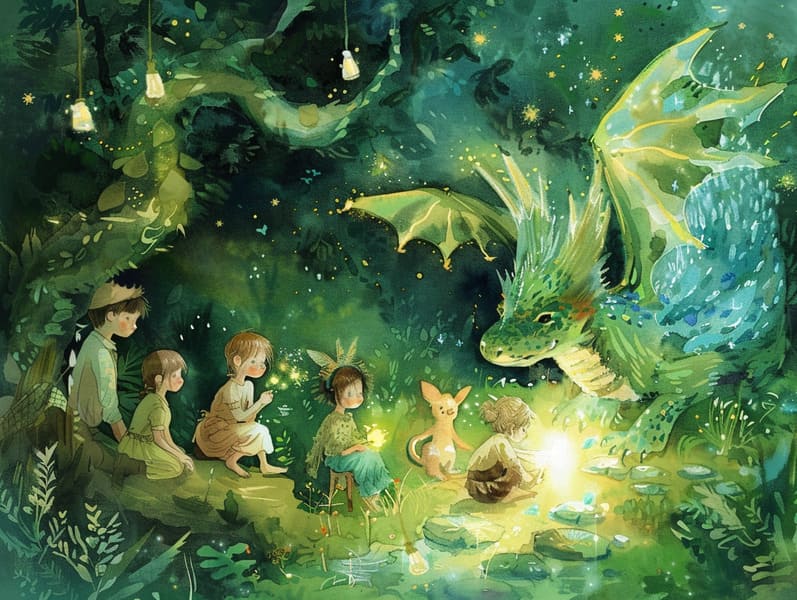Exploring the Wonder of Nighttime Adventures: Creating Treasured Memories with Your Loved Ones

Nightfall is a special time for caregivers and children. It’s a occasion to relax, snuggle, and delight in the beauty of bedtime narratives.
For years, nightly tales for children have been a esteemed custom, offering more than just a way to slumber. They provide an moment for bonding, development, and stimulating imagination.
Bedtime Stories: Essential Benefits
Bedtime stories for kids are not just a way to finish the day. They play a key role in a child’s growth and in strengthening the guardian-child relationship. Here’s why they are important:
1. Closeness Moments: Bedtime reading encourages a special bonding moment between adults and their kids. It’s a moment of proximity that helps children feel valued and protected.
2. Speech Improvement: Experiencing stories helps children develop their communication skills. They learn new vocabulary, understand grammar, and sharpen their attention and interpretation abilities.
3. Creative Thinking: Children's tales carry them to imaginary worlds, encouraging inventiveness. They envision characters, settings, and adventures, which fuels their innovation.
4. Feeling Recognition: Stories for little ones often depict characters facing difficulties and feelings. These narratives help kids handle and address their own moods, developing emotional growth.
5. Brain Growth: Engaging with a story helps children develop attention span, memory, and critical thinking skills. They enhance to follow stories, remember aspects, and guess endings.
Making Stories a Bedtime Habit
Establishing a bedtime habit that includes storytelling is doable and rewarding. Here’s how to make it a valued part of your night-time habit:
1. Pick a Cozy Area: Choose a comfortable place where you and your child can huddle together without disturbances. A relaxing bed or a relaxing reading nook works wonderfully.
2. Set a Consistent Time: Fix a regular time each night for bedtime stories. Routine helps children predict and makes the ritual easier to copyright.
3. Select Age-Appropriate Stories: Opt for tales that match your child’s cognitive level. Younger children might be engaged by visual books with simple narratives, while older kids may like longer stories with more complex plots.
4. Interact with the Story: Turn the tale feel vivid by using different voices for characters, adding special sounds, and getting your child to be involved. Ask queries about the story to involve them.
5. Create a Soothing Environment: Dim the lights, use whispers, and create a peaceful environment to help your child wind down.
Best Places for Bedtime Stories
There are numerous places to look where you can find excellent bedtime stories for children. Here are some ideas to think about:
1. Children’s Literature: Look at your nearby library or bookstore to find a wide selection of bedtime stories for kids. Exploring the options together can be a enjoyable activity that also enables children to choose stories that interest them.
2. Online Sources: There are many internet sites that offer free bedtime stories. Sites like online story sites provide a variety of short stories for kids that you can get for free. These sites are great for finding new and interesting stories without expense.
3. Apps for Storytelling: For nights when you’re too weary to read, look into audiobooks or storytelling apps. These can provide a gentle reading to read your child a story, ensuring they still get their bedtime story fix. Apps often offer interactive parts that can involve them further.
4. Custom Stories: Design your own stories matching your child’s experiences. Personalized stories can be extremely engaging and meaningful. You can incorporate your child in the creation process, making them a part of the adventure.
Benefits of Shorter Stories
Short stories for kids are especially helpful for bedtime. They provide all the good points of longer stories but are more concise, making them perfect for preparing for sleep before sleep. Here’s why short stories are a great choice:
1. Straightforward: To-the-point tales are easy and easy for children to follow, even after a long day. They check here can easily grasp the story and enjoy the story without getting lost.
2. Fast Engagement: These stories swiftly engage children, capturing their involvement and wonder. This makes them suitable for keeping bedtime practices simple yet enjoyable.
3. Many Choices: Compact stories allow for variety in your bedtime storytime. You can select a different story each night, keeping the practice interesting and exciting for your child.
4. Manages Time Well: For busy parents, compact stories are a easy way to make sure children still get their nightly dose of storytelling. They fit well into a packed schedule while still offering the full positives of a bedtime story.
"Read Me a Story": The Magic Phrase
The simple phrase, “Read me a book,” can open a world of magic for children. Responding to this request not only satisfies a child’s want for attention and engagement but also creates lasting memories. Here’s why it’s magical:
1. Tie: Sharing stories to your child builds a deep emotional link. It’s a time for closeness, sharing, and bonding.
2. Tradition: Creating a bedtime story routine creates a cherished tradition that children enjoy every night. It’s a practice that can be continued through generations.
3. Mutual Learning: As you read aloud, you’ll witness your child’s advancement and growth. Their interest, reactions, and understanding of the stories develop, offering insights into their developing minds.
4. Safe Space: Bedtime stories provide a safe space for children to understand emotions, face fears, and find comfort in the familiar presence of a parent.
End Thoughts
Children’s bedtime stories are a important tool for fostering a child’s evolution and developing unforgettable occasions of bonding.